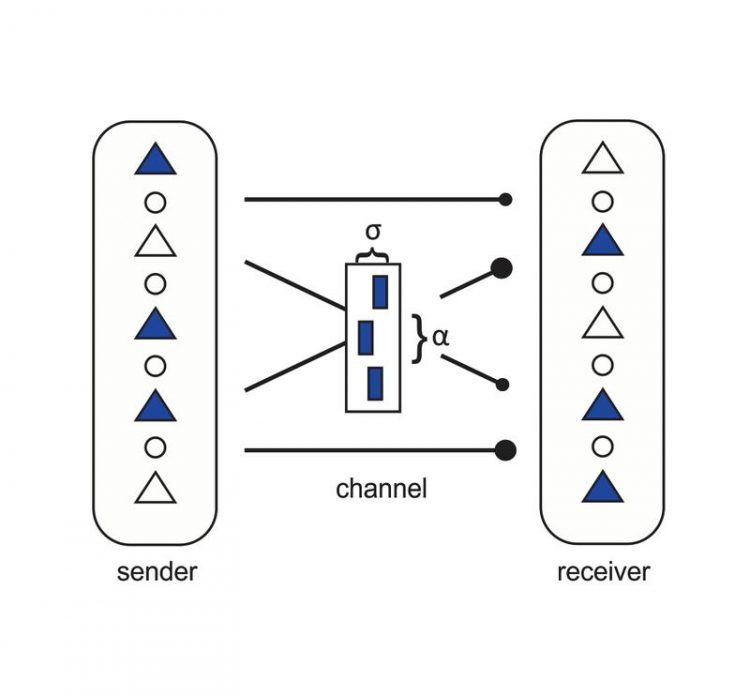Communication between neural networks

How do neural networks in different brain areas communicate with each other? The Bernstein Center Freiburg proposes a new model. Illustration: BCF
The brain is organized into a network of specialized networks of nerve cells. For such a brain architecture to function, these specialized networks – each located in a different brain area – need to be able to communicate with each other.
But which conditions are required for communication to take place and which control mechanisms work? Researchers at the Bernstein Center Freiburg and colleagues in Spain and Sweden are proposing a new model that combines three seemingly different explanatory models. Their conclusions have now been published in Nature Reviews Neuroscience.
The synthesis of Dr. Gerald Hahn (Pompeu Fabra University, Barcelona/Spain), Prof. Dr. Ad Aertsen (Bernstein Center Freiburg), Prof. Dr. Arvind Kumar (formerly Bernstein Center Freiburg, now KTH Royal Institute of Technology, Stockholm/Sweden) and colleagues is based on the theory of dynamic systems and takes particular account of how the level of activity of the respective networks influences the exchange of information.
The study combines three prominent explanatory models that have been proposed in recent years: synfire communication, communication through coherence and communication through resonance.
“We believe that our work helps to provide a better understanding as to how neuron populations interact, depending on the state of their network activity, and whether messages from a neuron group in brain area A can reach a neuron group in brain area B or not,” says Arvind Kumar.
“This insight is an essential prerequisite in understanding not only how a brain functions locally, within a limited area of the brain, but also more globally, across whole brain areas.”
The scientists were particularly interested in what role activity rhythms occurring in the brain – known as oscillations – play in communication. Typically these oscillations can affect anything from a large group of neurons up to entire brain areas and can either be slow, such as alpha or theta rhythms, or fast, such as the gamma rhythm.
In their theoretical model, the researchers were able to show that the interaction of these rhythms with each other plays a significant role in determining whether communication between networks can take place or not. Certain types of interlocking of these rhythms could act as important control mechanisms.
“The possibility of exchanging information depends on many factors, for example whether the oscillations are fast or slow, the frequencies are similar or different, the relationship between the phases and so on,” explains Ad Aertsen. “With our model, we are now able to make specific predictions for each of these cases. The next step will be to test these predictions in experiments.“
Detailed Information
http://www.bcf.uni-freiburg.de/news/18-12-17-aertsen-kumar
Original Publication
Hahn, G./Ponce-Alvarez, A./Deco, G./Aertsen, A./Kumar, A. (2018): Portraits of communication in neuronal networks. In: Nature Reviews Neuroscience.https://www.nature.com/articles/s41583-018-0094-0
Bernstein Center Freiburg
The Bernstein Center Freiburg is a central research facility for Computational Neuroscience and Neurotechnology at the University of Freiburg. At the BCF “Computational Neuroscience” is defined as the hypothesis driven research approach to unravel mechanisms of brain function and dysfunction using theory, simulation and experiment in a complementing, synergistic fashion.
http://www.bcf.uni-freiburg.de/about-us
Prof. Dr. Ad Aertsen
Faculty of Biology / Bernstein Center Freiburg
University of Freiburg
Phone: +49 (0) 761/203-9550
aertsen@biologie.uni-freiburg.de
Prof. Dr. Arvind Kumar
Department of Computational Science and Technology
KTH Royal Institute of Technology
Phone: +46 (8) 790 62 24
arvkumar@kth.se
Hahn, G./Ponce-Alvarez, A./Deco, G./Aertsen, A./Kumar, A. (2018): Portraits of communication in neuronal networks. In: Nature Reviews Neuroscience.
https://www.nature.com/articles/s41583-018-0094-0
https://www.pr.uni-freiburg.de/pm-en/press-releases-2018/communication-between-n…
Media Contact
All latest news from the category: Life Sciences and Chemistry
Articles and reports from the Life Sciences and chemistry area deal with applied and basic research into modern biology, chemistry and human medicine.
Valuable information can be found on a range of life sciences fields including bacteriology, biochemistry, bionics, bioinformatics, biophysics, biotechnology, genetics, geobotany, human biology, marine biology, microbiology, molecular biology, cellular biology, zoology, bioinorganic chemistry, microchemistry and environmental chemistry.
Newest articles

NASA: Mystery of life’s handedness deepens
The mystery of why life uses molecules with specific orientations has deepened with a NASA-funded discovery that RNA — a key molecule thought to have potentially held the instructions for…

What are the effects of historic lithium mining on water quality?
Study reveals low levels of common contaminants but high levels of other elements in waters associated with an abandoned lithium mine. Lithium ore and mining waste from a historic lithium…

Quantum-inspired design boosts efficiency of heat-to-electricity conversion
Rice engineers take unconventional route to improving thermophotovoltaic systems. Researchers at Rice University have found a new way to improve a key element of thermophotovoltaic (TPV) systems, which convert heat…



